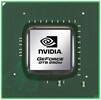Review Toshiba Qosmio X500-10V Notebook
Intel Core i7-720QM | NVIDIA GeForce GTS 250M | 18.40" | 4.8 kg

The Nividia GeForce GTS 250M is a DirectX 10.1 graphics adapter for notebooks based on the 40nm GT215 core. It features 96 shader cores as the 9800M GT, but the memory bus is only 128 bit wide. To compensate this, the GTS 250M supports GDDR5. With DDR3 graphics memory the performance is only a a bit above the Mobility Radeon HD 4670.
The core of the GTS250M is internally called GT215 and according to Nvidia based on the current high-end desktop architecture (GTX 200 series). Furthermore, Nvidia has improved the micro-architecture for further power saving and performance increases. Therefore, the performance per shader unit should be slightly improved compared to the previous generation.
As the GeForce 9800M GT, the GTS 250M features 96 stream processors that do the work of the former dedicated pixel- and vertex-shaders. The unified shaders of Nvidia are 1-dimensional (AMD has 5-dimensional shaders which leads to the higher number of shaders).
The GeForce GTS250M also supports CUDA, DirectX Compute, OpenCL, and PhysiX to use the shaders for other tasks than rendering images (like encoding videos, calculating the physics of a game or mathematical tasks). For these special tasks, the GPU can be noticeably faster than current CPUs.
The mobile graphics card has a built in video decoder called PureVideo HD with VP4. The Video Processor 4 (VP4) supports the full decoding of H.264, VC-1, and now also MPEG-4 ASP (e.g. DivX or XviD). MPEG-1 still wont be supported, but the decoding of this codec is quite trivial on a CPU.
In conjunction with a chipset from Nvidia with integrated graphics (e.g. 9400M), the GTS 250M supports Hybrid-SLI (HybridPower and GeForceBoost). HybridPower is a technique to choose between the integrated and dedicated graphics core, if performance or battery runtime is needed. This works only in Windows Vista (and possibly Windows 7). Up to now the user has to use a tool to switch between the GPUs. Later Nvidia wants to switch automatically in the drivers. GeForceBoost is not supported by the GTS 250M because the SLI combination would not perform better.
The performance of the middle class to high end gpu GeForce GTS 250M should be clearly above the GT 240M because of it features twice as much shader cores. Demanding DirectX 10 games like Crysis should run fluently in medium to high details. Older or less demanding games should run in high detail settings and high resolutions.
Depending on the the used type of graphics memory (GDDR5, GDDR3) the performance may differ.
The power consumption of the mobile graphics card is with 27 Watt TDP relativley low (especially as the GTS 260M which is a bit higher clocked needs 10 Watt more). Furthermore, according to Nvidia, the new improved core does only need half of the power in Idle mode (compared to the previous generation).
Compared to desktop graphics cards, the GeForce GTS 250M is similar to the GeForce GT 220. The desktop GPU is higher clocked (625/1360/500-1000) and therefore should be faster in games.
GeForce GTS 200M Series
| |||||||
| Codename | N10E-GE | ||||||
| Architecture | GT2xx | ||||||
| Pipelines | 96 - unified | ||||||
| Core Speed | 500 MHz | ||||||
| Shader Speed | 1250 MHz | ||||||
| Memory Speed | 1600 MHz | ||||||
| Memory Bus Width | 128 Bit | ||||||
| Memory Type | DDR3, GDDR3, GDDR5 | ||||||
| Max. Amount of Memory | 1024 MB | ||||||
| Shared Memory | no | ||||||
| API | DirectX 10.1, Shader 4.1 | ||||||
| Power Consumption | 28 Watt | ||||||
| Transistor Count | 727 Million | ||||||
| technology | 40 nm | ||||||
| Features | DirectX Compute Support (Windows 7), CUDA, OpenCL, HybridPower, PhysX, SLI, Powermizer 8.0, MXM 3.0 Type-B | ||||||
| Notebook Size | large | ||||||
| Date of Announcement | 15.06.2009 | ||||||
| Information | 360 Gigaflops | ||||||
| Link to Manufacturer Page | www.nvidia.com | ||||||
The following benchmarks stem from our benchmarks of review laptops. The performance depends on the used graphics memory, clock rate, processor, system settings, drivers, and operating systems. So the results don't have to be representative for all laptops with this GPU. For detailed information on the benchmark results, click on the fps number.

| low | med. | high | ultra | QHD | 4K | |
|---|---|---|---|---|---|---|
| CoD Modern Warfare 2 | 139.6 | 49 | 45 | 28 | ||
| Risen | 35 | 28 | ||||
| Need for Speed Shift | 41 | 36 | ||||
| Anno 1404 | 120.6 | 27 | ||||
| F.E.A.R. 2 | 69.4 | 45 | ||||
| Left 4 Dead | 152.3 | 89 | ||||
| Crysis - GPU Benchmark | 88.4 | 50 | 28 | |||
| Crysis - CPU Benchmark | 95.2 | 47 | 25 | |||
| Call of Juarez Benchmark | 16 | |||||
| low | med. | high | ultra | QHD | 4K | < 30 fps < 60 fps < 120 fps ≥ 120 fps | 2 3 | 5 1 | 4 3 1 | 2 | | |
For more games that might be playable and a list of all games and graphics cards visit our Gaming List
Velocity Micro NoteMagix M17: Intel Core i5-520M, 17.00", 3.2 kg
External Review » Velocity Micro NoteMagix M17
ZAReason Verix: Intel Core i7-620M, 15.40", 2.7 kg
External Review » ZAReason Verix
MSI GT740-i7247W7P: Intel Core i7-720QM, 17.00", 2.8 kg
External Review » MSI GT740-i7247W7P
Toshiba Qosmio X500-10W: Intel Core i7-720QM, 18.40", 1.7 kg
External Review » Toshiba Qosmio X500-10W
MSI GT740-021UK: Intel Core i7-720QM, 17.00", 3.2 kg
External Review » MSI GT740-021UK
Toshiba Qosmio X500-111: Intel Core i7-620M, 18.40", 4.6 kg
External Review » Toshiba Qosmio X500-111
MSI GT640-030UK: Intel Core i7-720QM, 15.40", 2.7 kg
External Review » MSI GT640-030UK
Toshiba Qosmio X500-110: Intel Core i7-720QM, 18.40", 4.5 kg
External Review » Toshiba Qosmio X500-110
Toshiba Qosmio X500-10T: Intel Core i7-720QM, 18.40", 4 kg
External Review » Toshiba Qosmio X500-10T
Ibuypower Battalion 101 LX-797: Intel Core i7-720QM, 17.00", 2.4 kg
External Review » Ibuypower Battalion 101 LX-797
Cyberpower Xplorer X7-7700: Intel Core i7-720QM, 17.00", 3.2 kg
External Review » Cyberpower Xplorer X7-7700
Toshiba Qosmio X500-10V: Intel Core i7-720QM, 18.40", 4.8 kg
External Review » Toshiba Qosmio X500-10V
MSI GT740: Intel Core i7-820QM, 17.00", 3.2 kg
External Review » MSI GT740
Acer Aspire 8940-6865: Intel Core i7-720QM, 18.40", 4.2 kg
External Review » Acer Aspire 8940-6865
MSI GT640: Intel Core i7-720QM, 15.40", 2.7 kg
External Review » MSI GT640
MSI GT640-i7247W7P: Intel Core i7-720QM, 15.40", 2.8 kg
External Review » MSI GT640-i7247W7P
Acer Aspire 8940G-724G64Bn: Intel Core i7-720QM, 18.40", 4.6 kg
External Review » Acer Aspire 8940G-724G64Bn
Acer Aspire 8940G-724G50Bn: Intel Core i7-720QM, 18.40", 4.2 kg
External Review » Acer Aspire 8940G-724G50Bn
Toshiba Qosmio X505: Intel Core i7-820QM, 18.40", 5 kg
External Review » Toshiba Qosmio X505
» Comparison of GPUs
Detailed list of all laptop GPUs sorted by class and performance.
» Benchmark List
Sort and restrict laptop GPUs based on performance in synthetic benchmarks.
» Notebook Gaming List
Playable games for each graphics card and their average FPS results.
Top 10 Laptops
Multimedia, Budget Multimedia, Gaming, Budget Gaming, Lightweight Gaming, Business, Budget Office, Workstation, Subnotebooks, Ultrabooks, Chromebooks
under 300 USD/Euros, under 500 USD/Euros, 1,000 USD/Euros, for University Students, Best Displays
Top 10 Smartphones
Smartphones, Phablets, ≤6-inch, Camera Smartphones